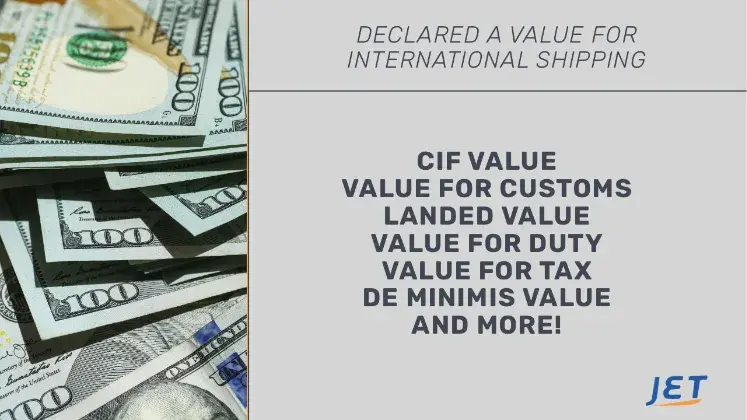
Useful rules when Declaring A Value When Shipping International Goods
When shipping international parcels, an important concept to understand is valuation. The declared value is a key determinant of the import process and duty assessment. Over declarations result in needless costs and under-declarations can result in significant fines and legal actions.

Optimizing Value Declarations for International Shipping
In this post explores the basics concepts regarding valuation for shipping parcels. Value is one of the elements for assessment of duty.
The three elements to determining the duty rate:
- Value of the Goods (see below)
- Origin of the Goods
- Customs tariff classification / HS Code
Disclaimer: The information in all Jet Worldwide online content, including this post, is for general information only.

When declaring a value for an international shipment, it is important to be accurate and have supporting documentation. Customs officials may inspect the package and verify its contents and value. While the basics are globally understood, the country of import may have specific requirements for value declarations.
Fill in form below for rates and feedback from our team.
What value declaration is correct when sending international shipments?
Generally, the best rule of thumb is to declare the amount you sold the goods for. If, for example, you sold the goods including shipping for $400, then you should declare $400 on your customs paperwork. In this case, best to include the term "CIF value." See section below for explanation of CIF value.
What value should I declare if I am sending free product samples?
If there is not a sales - or transaction value - you should assign a value of similar goods. When shipping samples or gifts, mention this on the invoice for customs.
Does a high value affect the shipping cost?
The value for customs of a shipment does not affect the shipping costs. However, the cost for insurance is usually a percentage of the value. Get international logistics support and shipping quote.
Why does customs sometimes use a higher value than the invoice value
Customs considers the cost of the goods, plus transport and insurance. This is the CIF value. Or value for duty. Shippers often only mention the value of the goods and do no show insurance or transport costs. If the term "CIF Value" is not on the invoice, customs will add to the invoice value. The value increase depends on method of shipping and a formula local customs uses. Another reason customs can assign a higher value is if they feel the invoice value is too low. Some customs ask for original invoices and receipts.
What is the de minimis value?
The de minimis value is the value under which most goods can import duty fee. Another term is the duty free low value threshold .
What value should I declare as a non-resident importer to Canada?
Generally, the transaction value paid by the ultimate buyer of the goods is the correct value for duty. Read more about value declaration for non-resident importers.
Ready to streamline your international shipping process? Contact our experts for personalized consultation.
We are happy to help with your shipping to and from Canada. Provide information about the type of goods, weight, dimensions, and preference of air vs sea freight?

When sending international shipments, it is important to understand the value rules that applies to your international shipment. For virtually every major country, the correct value is simply the “transaction value.” The transaction value is the amount paid for importing goods. But, for some international shipments, there is often not an actual transaction value. Such as sending samples or warranty parts.
Not having a clear transaction value occurs when when there is, in fact, no financial transaction. In this case, the value of similar goods can be a useful guide.
Consult with the receiver on which value to declare. Valuation is an important part of the import processes.
The World Customs Organization (WCO) guidelines generally in force in all major economies, Yet, there can be significant interpretational differences.
Related Resources
- Commercial invoice for international shipping
- Declared value, CIF & valuation for international shipping
- When to include a certificate of origin
- What is an HS code? Tariff classification basics
- Canada importer registration for CARM
- Canada export declaration (CERS): B13A
- What is a bill of lading or waybill?
- Choosing a Canadian customs broker
- Shipping via ocean freight to and from Canada
- Common CANADIAN IMPORT FEES
The key concepts to consider regarding value declarations
Valuation methods for international shipments:
The most common valuation method is to use the "transaction value:" The transaction value is the price actually payable for the goods. The payment made when bought for export to the country of importation.
Transaction Value between related Parties
Note that the transaction value between related companies and subsidiaries complicates things. Review both import and tax regulations. Transactions involving a foreign importer of record or non-resident importer can also have challenges withs respect to valuation.
Adjustments can include the addition of the cost of transportation and insurance. If, for example, you buy an item for $1,000 and cost of transportation and insurance was $90. The transaction value would be $1,090.
Virtually all countries accept the transaction value as the appropriate amount to declare upon import.
Alternatives to using the Transaction Value for international shipments:
When the transaction value is not possible, one of the following methods can be useful:
- The transaction value of identical goods
- The transaction value of similar goods
- The deductive value method
- The computation value method
- The fall-back method.
The above valuation methods are in hierarchical order.
Resource page: International resources and rules for declaring a value.
When declaring a value for your international shipment, the transaction value is mostly just common sense. The following two methods (value of identical or similar goods) are self explanatory.
Deductive, computation and fall-back methods can get technical. For high value, specific commodities and cases where determining the value is not immediately clear, get advice from professionals.

What is Deductive Value?
Basically, deductive value is the resale price after import with deductions for certain items. The deductive generally starts with a unit price. From this point certain additions to and deductions will apply from that price.
What is Computed Value?
Computed value consists of the sum of the materials and processing costs, plus packing, profit and general expenses
What is Fall Back Method?
If none of the previous methods apply directly, the value with derive from one of the five previous methods with adjustments.
What is CIF Value?
Most customs authorities consider the value for duty or "landing cost" to be the cost of the goods, plus insurance and freight (shipping). CIF = Cost + Insurance + Freight.

When declaring a value on a customs invoice, it is best to expressly include the shipping and freight cost. This is part of the transaction value. Be sure to clearly note that the value is the "CIF Value." Otherwise, customs might add an amount for shipping and insurance.
For example, if the transportation and insurance cost to ship goods worth $1,000 are $200, the CIF value is $1,200. Duty calculation is on $1,200, not $1,000.
Understand the difference between CIF Value versus CIF Shipping Term
Cost, Insurance, and Freight (CIF) is one of the11 Incoterms® rulesset by the International Chamber of Commerce. When used as a shipping term, it represents the charges paid by a seller to cover the costs, insurance, and freight.We recommend showing the CIF value by itemizing the cost of goods, shipping and insurance cost on the commercial invoice. But to also to clearly specify the shipping terms.
Note: This blog is meant for general information only. Ensure compliance with your carrier, customs brokers, customs and other regulatory authorities prior to shipping.
Does US customs consider CIF value?
US Customs considers only the cost of the goods as the value for duty.
The transaction value of imported merchandise is the price actually paid or payable for the merchandise when sold for exportation to the United States, plus amounts equal to:
- The packing costs incurred by the buyer
- Any selling commission incurred by the buyer
- The value, apportioned as appropriate, of any assist
- Any royalty or license fees as a condition of the sale
- The proceeds of any subsequent resale, disposal, or use that accrue to the seller
First Sale Rule and valuation to USA for e-commerce imports
A US customs valuation principle known as the “First Sale Rule. ” In theory implies that declaring a the manufacturer’s cost as the value may be acceptable when certain conditions are met. But, the retail cost transaction to the US consumer is considered the default valuation.
The burden of proof on the importer to validate that the conditions for the First Sale Rule met are extraordinary and require legal guidance. We do not recommend this method as the potential savings may not be worth the risk and cost of compliance.
Learn more about First Sale Rule for USA imports
What is Intrinsic value?
Intrinsic value refers to the price of the goods themselves when sold for export. It excludes transport and insurance costs, unless they are inclusive in the price. If price includes shipping and insurance it must be on the invoice. For goods of a non-commercial nature, the price which for payment for the goods themselves
Consignment versus Goods
The term “consignment” refers that ship together from a single consignor to a single consignee. A consignment is via the same transport waybill and tracking number.
De Minimis Value
Most countries will - or already have - eliminated their duty free threshold.
What is the difference between CARM and CERS?
After establishing the value and other information, the next step is to review the international shipping options export and import to Canada.
Local parcel post solutions are best for individuals shipping small packages and personal items
Ocean shipping is for large commercial orders and shipping containers with lead times of between 1-3 months.
Forwarders combine multiple modes of shipping with other logistics functions.
FedEx, DHL and UPS are well known brands that offer integrated international air options.
Jet Worldwide: A trusted brand with over 40 years! Jet provides logistics support including discount access to global carriers. Along with world class customer support.






